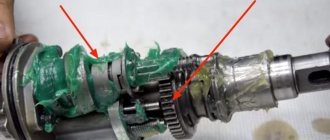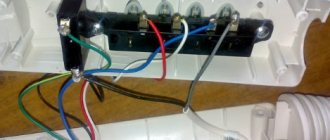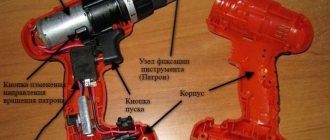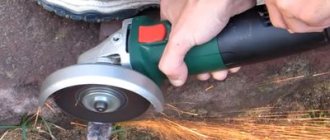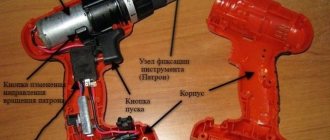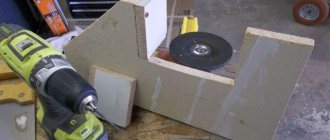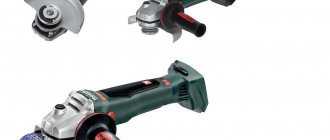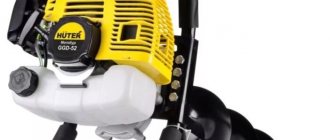Characteristics and features of lubricants for angle grinders
When servicing any hand tool with moving parts, a lubricant is used that has the following characteristics and features:
- It should not contain solid particles that could cause chipping of the moving parts of the mechanism.
- The temperature at which the lubricant becomes liquid must be more than 120 degrees.
- The oil should not absorb moisture and should form a durable film that protects parts from corrosion.
- And also, most importantly, the oil must be of such viscosity that it is able to adhere to moving parts.
Makita grease
Bosch lubricant
Mobil lubricant
The consistency or viscosity of lubricants is classified according to the NLGI (National Lubricating Grease Institute), and in certain cases it is necessary to use oil of a certain thickness. The viscosity of the oil is selected depending on the speed of the gearbox; the higher it is, the thinner the oil should be. So, depending on the tool, the viscosity is selected:
- Drills, hammer drills, jigsaws, where the gearbox has a low rotation speed. Lubricant with index NLGI-2 which is soft.
- Lightweight rotary hammers and impact drills. Class NLGI-1, very soft consistency.
- Angle grinders, circular saws, brush cutters. Class NLGI-0, semi-liquid consistency.
- Heavy hammer drills, jackhammers. Class NLGI-00, consistency is liquid.
Lubricant for angle grinder gearbox
Almost all global tool manufacturers require the use of their recommended “own” lubricant, sold under their brand. In principle this is correct. The lubricant used for the angle grinder gearbox, in this case, is tested at the manufacturer; it guarantees long-term and proper operation of the angle grinder. However, there are some drawbacks, which include the high price of lubricants from these brands.
Lubricant for open angle grinder gearbox
In addition to original oils, there are many lubricants on the market produced by third-party manufacturers, so the question of what exactly to lubricate the gearbox of an angle grinder is not an urgent one.
Products from Haskey, Castrol, Liqui Moly and others have proven themselves to be good for adding to an angle grinder gearbox.
Russian manufacturers also keep up with foreign ones and offer their products. Thus, the lubrication of bevel gear angle grinders from . Of course, such gear lubricant is not original and recommended by the manufacturer, so if it is used, subsequent warranty repairs may simply be refused.
Ready-made lubricants
As a rule, the manufacturer requires customers to use only products of their brand to lubricate the gearboxes of an angle grinder. And this is quite understandable. All lubricants undergo rigorous tests directly at the company’s factory. The manufacturer selects the composition and manufacturing technology in such a way as to obtain a product that maximizes the service life of parts. At the same time, lubricants from tool manufacturers also have a disadvantage - their high price.
Instead of oils directly from the manufacturer, it is quite possible to use high-quality alternatives. In this case, you should carefully read the required properties that the manufacturer described in the instructions for the grinder. Several popular alternative brands of lubricants: Haskey, Castrol, Liqui Moly, as well as the domestic offer “Nanotech”.
It is better to lubricate a device whose warranty period has not yet expired with a branded product. Otherwise, if the angle grinder breaks down, you may be denied repairs at the seller’s expense.
The correct process for packing lubricant into angle grinders
After the choice of lubricant for the angle grinder has been made, they proceed directly to servicing the tool. The correct maintenance process for an angle grinder consists of several steps. First you need to open the gearbox, then remove the old lubricant, apply a new one, and check the correct application. Removing the old lubricant is necessary for the reason that when mixed with the new one, it will not allow it to work correctly and the entire maintenance procedure will not bring any results.
Proper filling of lubricant in angle grinders
Gearbox maintenance
Having chosen how to lubricate the grinder gearbox, as well as preparing the mechanism for this process, you can begin servicing the tool. The product must be mixed thoroughly. It is applied in a thin layer to the gearbox parts. The mass is applied to the bearings using the packing method.
If the product is packaged in a tube, its neck is placed on the side of the bearing cage. The composition is poured inside until it flows out from the other side. Enough grease is filled into the gearbox so that it covers the gear teeth. The excess will flow out when the grinder is in use. Lack of lubrication leads to increased heat and friction inside the mechanism.
Experts recommend adding such an amount of substance so that it occupies almost half the space of the gearbox housing. In this case, the operation of the tool will be correct. The manufacturer may indicate in the operating instructions some of the nuances of this process. They should also be taken into account when servicing angle grinders.
When to change the grease in an angle grinder
The frequency of replacing the lubricant depends on how often and under what loads the tool is used. As a rule, this period is approximately a year. In case of intensive use with frequent overheating, the replacement frequency is reduced to six months, sometimes more often.
To carry out maintenance, you will need to disassemble the angle grinder gearbox by unscrewing the 4 screws on its cover.
After removing the cover, you can see two bevel helical gears: a large gear and a small gear. The small gear is anchored and drives the large gear. The large one, in turn, is mounted on a secondary shaft, to which a cutting or grinding disc is attached.
How to properly remove old grease from an angle grinder
The disassembled grinder gearbox must be thoroughly cleaned of old lubricant. It no longer performs its functions, plus solid particles have already accumulated in it, resulting from wear of moving parts. When mixed with a new one, the old lubricant also significantly worsens its characteristics. Therefore, the gearbox and gears must be thoroughly cleaned.
Removing old grease from the gearbox
Remove old grease with a rag, paper towel or just a rag. Removed parts can also be washed in gasoline or solvent. Before assembly, the washed parts must be thoroughly dried. Residues of solvent or gasoline will mix with the new lubricant and change its consistency, which will again worsen its performance.
How to lubricate the gearbox
First of all, it is necessary to disconnect the equipment from the network and clean the housing from dust, dirt and other construction debris. The lubrication procedure includes several stages: opening the protective cover, disassembling the gearbox, cleaning off the old lubricant, pouring in a new one and checking.
Removing old grease
The gearbox must be cleaned of any remaining old grease and wear. Under no circumstances should you add a new lubricant by mixing it with the old one. The fact is that used lubricant contains solid particles.
First remove old grease
Advice! It is better to remove old grease with a soft cloth that absorbs moisture well. You can also use paper towels. An ordinary rag will simply drive dirt and solid particles around the gearbox without absorbing anything.
All parts must be treated in solvent or gasoline, and then dried thoroughly. Neither the first nor the second should get into the new lubricant, because they will change its characteristics for the worse.
Applying lubricant
Before pouring, you should make sure that there are no foreign elements in the composition, and that the consistency is uniform - without lumps or light/dark spots. Lubricant is applied to moving parts in a thin layer, but in such a way that it covers all areas of the mechanism.
The easiest way to add lubricant to bearings is with a regular syringe. After processing the parts, you can pour the composition into the gearbox.
Lubricant quantity
Allowable volumes of material are indicated in the operating instructions. Excessive lubricant is no less detrimental to a tool than its lack. The lubricant should completely cover the gear teeth. Due to an insufficient amount of material, the moving parts will quickly wear out, and the tool itself will begin to smoke under heavy load.
Excess lubricant makes it difficult for parts to work, plus oil will ooze through all the cracks and fasteners.
Advice! In the absence of documentation for the equipment, you can rely on figures of 40-50% of the lubricant from the total capacity of the gearbox.
Control of composition application
The last step in changing the lubricant is to check the equipment in light mode. After assembling the structure, you need to make sure that all parts fit tightly together and the fasteners are securely tightened. The semi-liquid composition NLGI 0 can seep even into tiny holes, especially during prolonged operation of the equipment, when the oil is heated above 100⁰C.
We turn on the angle grinder at low speed and make sure that there are no extraneous sounds. When you first start it up, a slight burning smell is considered normal: it should disappear in less than a minute. If this does not happen, then the equipment must be turned off and the build quality checked.
Particular attention should be paid to the temperature of the gear unit. The lubricant's job is to distribute heat evenly. Standard temperature indicators for the engine and the structure as a whole are indicated in the specification for the angle grinder. They should not exceed the norm.
After the dry check, the equipment must be disassembled and the correct application of lubricant must be assessed. We open the gearbox and inspect the helical gears. If they are completely covered with lubricant, it means it has been applied correctly. Excess can be seen almost immediately after turning on the machine: oil in the cracks and in the places where the gearbox is attached.
The procedure for applying lubricant to the grinder gearbox
Before applying new lubricant, it must be thoroughly mixed and ensure that there are no lumps or foreign objects in it. Apply a thin layer of lubricant to the gears, ensuring that it completely covers the teeth. It is more convenient to fill the bearings with grease using a syringe. Then the lubricant intended for angle grinders is driven into the gear housing. This is necessary for the reason that during operation it can fly off the gears and if there is a small amount of it, the gears will run “dry”.
How much lubricant should be used when replacing an angle grinder gearbox?
The volume of lubricant put into the gearbox must be such that the oblique teeth of the gears are completely covered with it. An excess will lead to it being squeezed out from under the cover, and an insufficient amount will not ensure proper operation of the gearbox.
It is best to rely on the amount that was supplied by the manufacturer of the angle grinder, but you must remember that the lubricant can dry out and decrease in volume.
In this regard, it is better to put a little more and check the correct distribution of the lubricant after turning on the angle grinder. In general, the amount of lubricant is usually approximately 30–50% of the total capacity of the gearbox.
Lubricant applied to the gearbox
Types of lubricants for grinders
Experienced users recommend using lubricant from the tool manufacturer for a specific angle grinder model. This will eliminate unpleasant consequences. When using another product, the manufacturer may refuse to exchange the broken tool under warranty or accept it for repair. Many do not follow this rule, because the formulations from the manufacturer are expensive. All lubricants are divided into types:
- branded composition, according to the logo of the tool manufacturer;
- lubricants for CV joints;
- old proven classics - solid oil and litol.
If it is not possible to buy a branded product, then it is better to buy a composition for the CV joint. In Russia, such compounds are offered in many car dealerships. There is no need to think that this option is very bad. The instrument will receive good protection. As a last resort, you can use lithol or solid oil, but you need to be prepared for the fact that the tool will quickly break. These products are not suitable for high temperature applications.
Checking the correct application of lubricant to the angle grinder gearbox
The last step when servicing an angle grinder is to ensure that the lubricant is properly applied and distributed inside the gearbox. To do this, after the gear unit has been assembled, turn on the power tool without load for several minutes, while ensuring that there are no extraneous sounds, smells, etc. If they occur, you must immediately disconnect the angle grinder from the network. The heating of the gear unit is also checked. The lubricant must distribute heat evenly and the temperature of the gear unit should not be very high.
After some work, unscrew the 4 screws, then remove the cover from the gearbox. The helical gears should be visually inspected for the presence of lubricant. If it is missing, it means that too little lubricant was used and should be reported. If during work it is squeezed out of the cracks, then it means that there is too much of it and the excess should be removed. After making any changes, check the operation of the angle grinder again without load.
How to properly remove old grease and apply new one
The following is an overview that clearly demonstrates changing the lubricant. In addition, the process of removing old and applying new lubricant is described in detail.
- For safety , disconnect the grinder's cable from the mains during any maintenance work, including replacing the wheel or adjusting the casing.
- Before opening the gearbox, remove the replacement tool (wheel or cord brush) and protective casing. Wipe the outer surfaces of the cover and body with a rag moistened with gasoline. Remove the plan washer from the spindle .
- After unscrewing the screws, remove the gearbox cover along with the driven gear and spindle.
- Remove any old grease from the gearbox housing and drive gear
- Remove the spindle with the driven gear and bearing clean them thoroughly .
- Wash all surfaces with gasoline using a stiff brush. Blow out the gearbox and removed parts and dry them.
- Advice. The design of some grinders provides the ability to adjust the gap in the gearing.
- For such “machines”, it is useful, after cleaning and washing, to assemble the gearbox and briefly turn it on “by ear” to check for a possible increase in the gaps in the gear mesh. Additionally, you can check by rocking the spindle in the axial and radial direction (disconnecting the cable from the network!).
- Apply new grease to the gear teeth , cover and gear housing in an amount approximately equal to what you removed during cleaning. Add a little, adjusting for waste.
- After assembling the gearbox, plug in the grinder and let it run for a few minutes at idle until the gearbox heats up slightly.
- If a small amount of grease has squeezed out from the cover groove around the spindle, remove it with a clean rag.
That's it, the lubricant has been replaced, the grinder is ready for further work.
Video
Useful video about choosing and replacing lubricant for angle grinders, drills and other tools.
Review of lubricants for grinders
It was previously said that there are many types of lubricants, both from foreign and domestic manufacturers. A good lubricant for power tool gearboxes is produced by Bosh. It’s called “Gearbox Lubricant” and is packaged in 65 gram tubes. One such tube is enough for several grinder maintenance.
Lubricant for grinder gearboxes of various brands
Of the lubricants intended for grinder gearboxes produced by domestic manufacturers, we can recommend products. It is called “Nanotech MetalPlak Electra” and is intended for tools that work under intense load. Also among domestic lubricants, CV joints or Tsiatim-221 are widely used, but they require preliminary preparation and, in fact, are a homemade lubricant.
DIY grease for an angle grinder
A self-made lubricant for grinder gears consists of a base and a diluent. The basis of homemade lubricant is usually a CV joint with molybdenum disulfide or Tsiatim-221. They have a second NLGI viscosity, so for use in an angle grinder gearbox, the base must be diluted. As a diluent, it is best to use simple mineral industrial oil, which, for example, is I-20 oil. To obtain a viscosity of NLGI 0, you will need to mix approximately 70 percent base and 30 percent thinner. The resulting mixture is thoroughly mixed and ready for application to gears and bearings of angle grinders.
Making your own lubricant
Timely maintenance of any electric tool is the key to its long-term and trouble-free operation. A properly functioning tool is also a guarantee of safety for the person using it. Using the tips given above, everyone can choose the right lubricant for the angle grinder gearbox and replace it without resorting to the help of expensive power tool service centers.
